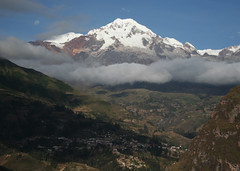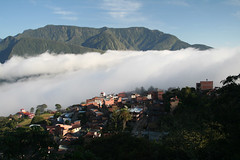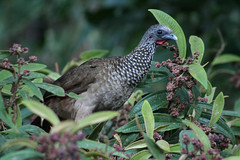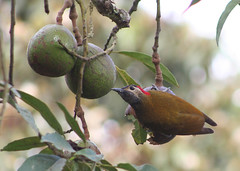We visited Sorata last weekend. I had hoped to post a blog entry then but did not find the time before we left for Coroico this past weekend. So I'm combining the two towns into a single post (more bang for your boliviano.)
Sorata is difficult to describe. A small town by USA standards, it is nonetheless the commercial and cultural center of the valley to whose very steep walls it clings. Each morning, the townspeople of Sorata and the abundant European and Israeli tourists (and a few Americans) greet the gigantic, glaciated crags of Nevado Illampú, which tower above the town. The mountain draws more people to Sorata than even the beautiful canyons and exceptional mountain-biking opportunities. Illampú is the most difficult ascent out of all the peaks of Bolivia's magnificent Cordillera Real, and attracts hardcore mountaineering types as well as more prudent tourists who just want to visit a glacial lake or two and spend a couple of days in Sorata, which has been described, accurately, as Shangri-La.
We spent quite a bit of our time in Sorata on the trail. Conga the Mountain Dog, a.k.a. Gizmo, accompanied us everywhere we went on our first day out. She climbed hills faster than we did, skidded down scree slopes more gracefully, and seemed to know where we were headed before we could even figure it out! We learned later that evening that Conga regularly disappears for up to a week at a time on similar adventures, sometimes wandering so long without food that by the time she gets back home she’s become seriously malnourished and feeble. We thought our ten-hour day of rock-hopping in the riverbed had worn her out, but it to her it must have felt like a leisurely stroll through the park!
The next day we planned an ambitious fourteen-kilometer hike along the river canyon to the town of San Pedro, where a navigable cavern, the Gruta de San Pedro, beckons tourists with colonies of bats and an underground lake. We headed out early, but because we stopped for every interesting plant and photo opportunity, we only made it halfway there by the end of the afternoon. We raced some Israeli tourists back to the finest Swiss-baked cake Sorata has to offer at a café up the hill from our campsite (we won), then ate an enormous dinner of goulash and mashed potatoes, and passed out.
We departed Sorata on a minibus headed southbound back to La Paz, with our backpacks crammed on the roof rack, and ourselves crammed into the back seat. In this country of overwhelming Aymara and Quechua heritage, standing taller than five feet six inches puts you at a serious disadvantage. Not only do Wayne and I manage to whack our heads on every other bathroom doorjam, we also seem to get lucky quite often and end up in the back seat of the minibus on long distance trips. At six feet tall, we do not fit very well into the back seats of the minibuses! But we survived the mercifully short three hour trip, and checked back into our hotel for another week of paper pushing, which turned out to be much shorter than we expected. We exhausted our list of tasks in just two days, and then set out for Coroico, this time armed and dangerous with a plant press and official permission to collect.
Coroico lies about 80 km northeast of La Paz, in the range of Andean foothills known as the Yungas, and at a mere six thousand feet above sea level, enjoys a much warmer, wetter climate than either the Altiplano or Sorata. It is a destination for tourists and vacationing Bolivian highlanders, and feels like a resort town, with secluded bungalows scattered throughout the surrounding hills. We picked a particularly secluded one that was recommended by the guidebook, but when we arrived at ten pm, nobody was home! Fortunately the door to the main guesthouse was ajar, so we selected some dorm beds and made ourselves at home in spite of the receptionist's absence. Nobody even batted an eyelash the next morning when we walked downstairs for breakfast.
Birds outnumber people in Coroico. Spending a morning watching the forest canopy will confirm this beyond any doubt. Actually figuring out the proportion, however, is more difficult. Most of the birds are usually heard and rarely seen. Some of the birds, like this pheasant-looking number on the right, make every effort toward invisibility, ducking behind branches or flapping away immediately upon making eye contact with any human. But many of them make such loud and raucous noises so frequently that in spite of their stealthy movements, it remains almost impossible not to know where they are at all times. This is especially true in the very early morning, when several species seem to prefer to screech their welcome to the day from perches just outside the hostel windows. Actually, it's quite convenient that these birds choose to squawk next to the windows. It really simplifies the process of birdwatching. I got some great bird photos one morning (including the photo on the right) without even getting out of bed!
Each morning, flocks of fluorescent green parrots cruise over the town and its surroundings, squawking unceremoniously as they fly to their daytime hangouts in the valley below. Shimmering blue and green hummingbirds flit obsessively to and fro among the blossoms of the Inga trees, vigorously attacking any rivals who make the mistake of encroaching upon their territories, while the beautiful and much more secretive trogons glide silently among the branches of the shade trees in the coffee plantations on the hillside. The occasional tropical woodpecker may also be seen, enjoying the pleasures of an avocado by the side of the road.
We spent our last morning in Coroico fighting off the abundant biting insects and nursing our legs (quite sore after three days of hiking the steep trails of the valley slopes). That afternoon we caught a bus back to La Paz, which brought us through lush cloud forests into sparse highland grasslands, and finally into the upper reaches of the city, where the familiar odors of diesel smoke and fried chicken welcomed us back. After a brief taxi ride to our hotel, we lugged the now overflowing plant press up to our second story room and commenced our re-acclimation to the altitude.
Now we'e been pushing papers again for a couple of days. We almost have our visa extensions, after only three weeks of waiting! Assuming that all goes well, we'll soon head southwest to the town of Uyuni and some of the most amazing scenery in Bolivia. I've heard people compare the Bolivian southwest to the surface of the moon. More photos and stories will certainly follow.
Subscribe to:
Post Comments (Atom)






No comments:
Post a Comment